It's all about the classical music composers and their works from the last 400 years and much more about music. Hier erfahren Sie alles über die klassischen Komponisten und ihre Meisterwerke der letzten vierhundert Jahre und vieles mehr über Klassische Musik.
Total Pageviews
Friday, January 31, 2025
Famous Quotes from Wolfgang Amadeus Mozart
by Hermione Lai, Interlude
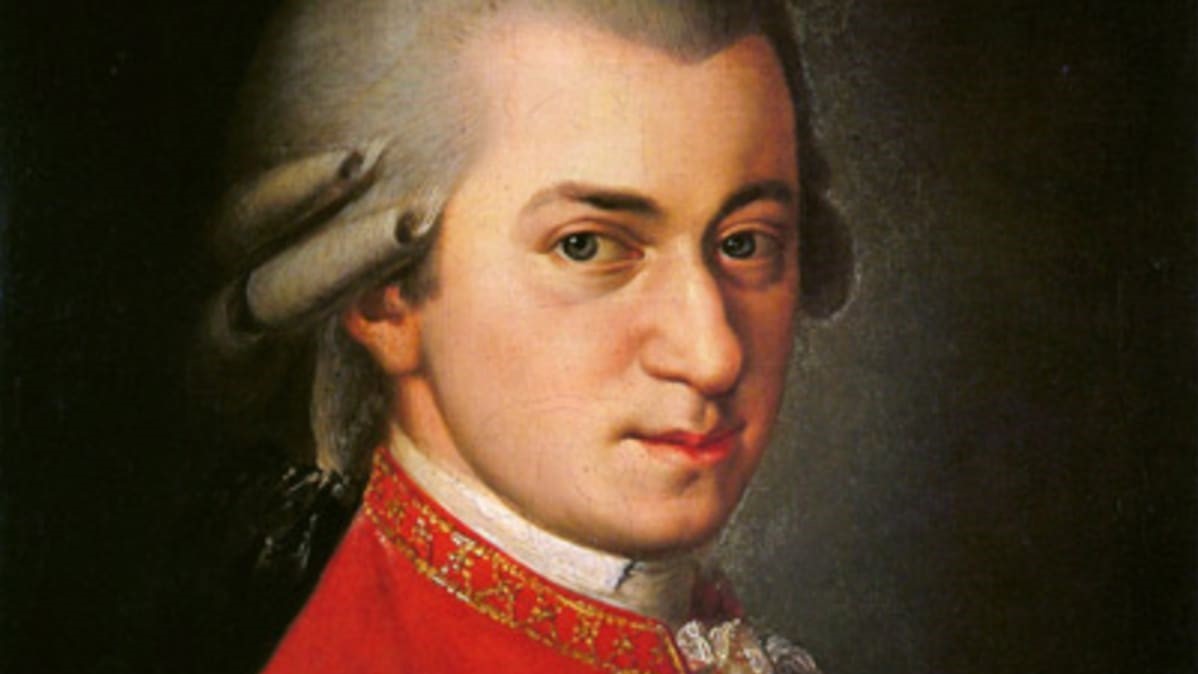
Wolfgang Amadeus Mozart
If we can trust current scholarly opinion, Mozart was a distinguished letter writer. In fact, he is described as “the most eloquent among musicians of his time.” During his travels he was a faithful correspondent, he wrote loving letters to his wife, and long money-seeking letters to friends and patrons. And as we all know, he also wrote some rather naughty letters to his cousin. As an artist profoundly inspired by the theatre, Mozart was an exceptional judge of character. And his letters are not “exotic discoveries suitable for being marveled at in a distant cabinet, but are bearers of communications.”
Wolfgang Amadeus Mozart: Clarinet Concerto, K. 622
The Mozart letters are full of both trivial and important observations about the people he met, comments on the reactions to his music, satirical remarks on incompetent professions, thoughts on other composers, the process of performing, and his own methods of composition. But writing a blog on famous quotes from Wolfgang Amadeus Mozart is not so easy. His use of language, his “use of dialect, semantics, and phonology can be difficult for the 21st-century readers to fully understand.” Nevertheless, here are some famous quotes from Wolfgang Amadeus Mozart that present an informal and intimately detailed portrait of a genius.
“Nothing is more enjoyable than a quiet life and to obtain that, one must be industrious”
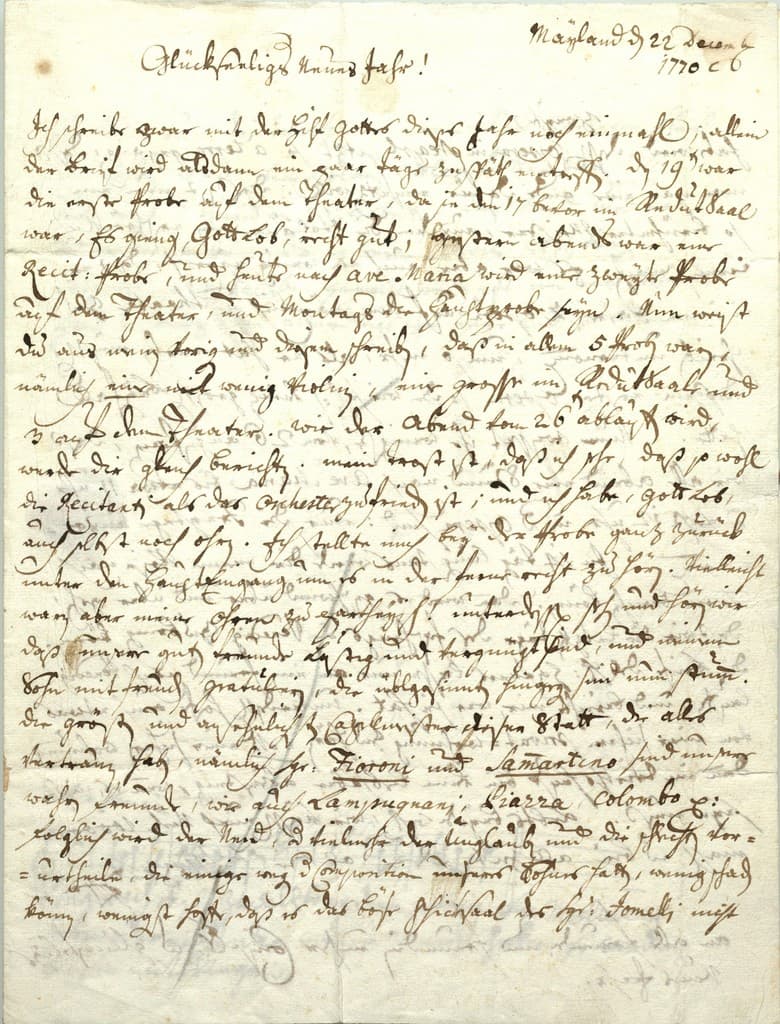
Mozart’s letters
As he wrote to his wife on 8 October 1791, Mozart was probably longing for a life exclusively dedicated to music, without all that financial stuff. He did have a habit of exaggerating his financial difficulties, but he certainly liked fine clothing, expensive apartments, and enjoyed living beyond his means. Some commentators have suggested that he might well have had a gambling problem as well. But one thing is for sure, he was incredibly industrious as a composer. The amount and quality of music composed during his short life is simply staggering. He left us roughly 800 works in virtually every genre of his time of the highest possible quality imaginable.
Wolfgang Amadeus Mozart: Piano Concerto No. 10 for two pianos in E-flat Major, K. 365 “Allegro”
“Friends who have no religion cannot be long our friends”
Mozart was baptized a Catholic, and the church played an important role in his life. He was raised in a strict religious household with his father enforcing family prayer, fasting, the veneration of saints, regular attendance at mass, and frequent confession. In the words of Leopold Mozart, “God must come first! From his hands, we receive our temporal happiness and our eternal salvation.”
It is hardly surprising that the above famous quote from Wolfgang Amadeus Mozart originates in a letter written to his father in 1782. However, Mozart’s relationship to religion was ambivalent, and his famous quote does not provide reliable information about his convictions but is probably a disguise in order to please his father. But that doesn’t mean that he didn’t compose some of the most spiritual and devotional religious music in existence.
Wolfgang Amadeus Mozart: Ave verum corpus, K. 618
“Constanze is not ugly, but anything but beautiful; all her beauty consists of two little black eyes and a handsome figure”
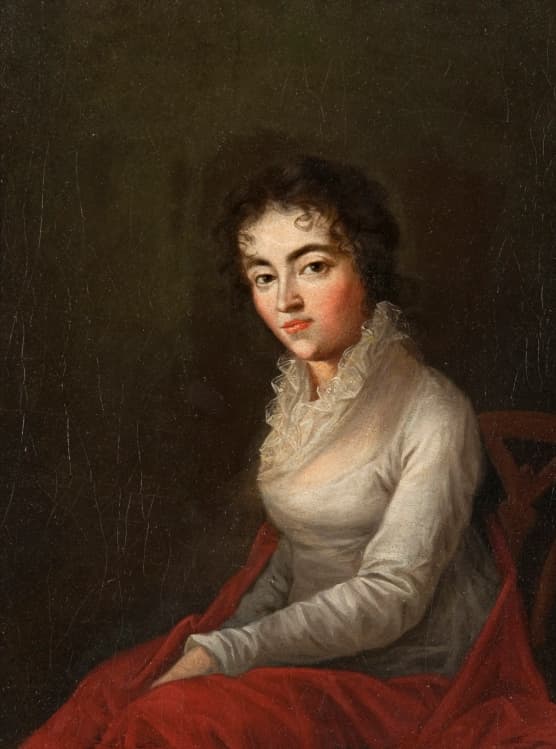
Constanze Mozart
Wolfgang Amadeus Mozart married Constanze Weber on 4 August 1782. Their courtship had not been smooth, and the relationship faced stiff opposition from Leopold Mozart. Leopold did not consider Constanze a good match for his son and didn’t want the marriage to go ahead. A good many letters went back and forth, with Mozart praising the talents of his love and Leopold refusing to let his mind be changed.
It probably didn’t help that the couple moved in together before they were married, making it a real disgrace for the time. Her mother threatened to call the police if she didn’t return home. In the end, Leopold could not prevent the marriage and in order to save face, his consent arrived in the mail one day after the happy event.
Wolfgang Amadeus Mozart: Piano Sonata No. 11 in A Major, K. 331
“To win applause one must write stuff so simple that a coachman might sing it”
Wolfgang Amadeus Mozart always placed great emphasis on elegant, natural, and singing melodies. He always wanted to communicate through melody. Mozart was essentially an operatic composer, and that particular style carried over into his instrumental works as well. In order to effectively perform Mozart’s music, we need to think like an opera singer but with simplicity of melody that can be easily sung by a coachman as well. In a related famous quote, Mozart wrote, “Melody is the essence of music.”
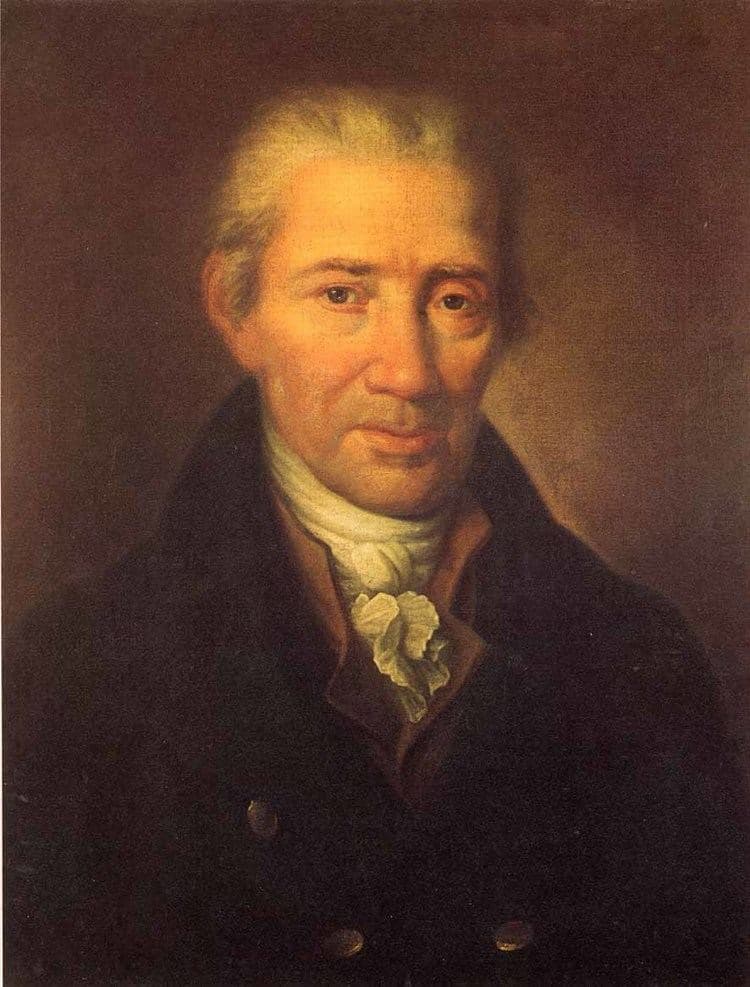
Antonio Salieri
To be sure, Mozart melodies are some of the most memorable pieces of music ever written. Mozart melodies are frequently described as flowing and beautiful, with an unmatched lightness and elegance. Some writers compare them to the sounds of a flowing river or the gentle flutter of a butterfly’s wing. But while they are light and airy, they have deep emotional qualities. Mozart’s melodies have a way of touching the soul and stirring emotions. Remember the Salieri movie, when the jealous composer commented upon hearing a Mozart melody that he had heard the voice of God?
Wolfgang Amadeus Mozart: Le Nozze di Figaro, “Voi che sapete”
“It is a mistake to think that the practice of my art has become easy to me. I assure you, dear friend, no one has given so much care to the study of composition as I”
Wolfgang Amadeus Mozart was a true child prodigy, and he is very often considered an exceptional and singular musical genius. As a performer, he quickly acquired superstar status and began to compose at the tender age of five. He completed his first symphony before celebrating his eighth birthday and finished his first opera by the age of twelve. And while his natural ability is undisputed, he remained a student throughout his life.
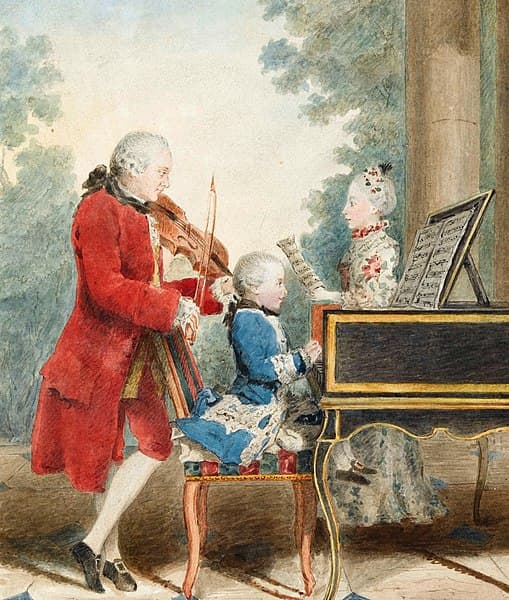
The Mozart family playing chamber music
Mozart unrelentingly integrated, synthesized, and transformed stylistic and musical conventions to produce compositions of universal appeal and stunning individuality. There simply seems to have been no genre or compositional technique in which Mozart was not comfortable. Mozart certainly worked on his compositional craft after he moved to Vienna, and for the first time saw musical manuscripts by J.S. Bach and Handel. He immediately started a concentrated study of counterpoint and began to improvise fugues in the style of Bach. And it was the synthesis of the Classical and learned styles of music that made the true genius of Mozart’s music.
Wolfgang Amadeus Mozart: String Quintet in D Major, K. 593
“How popular I would be if I were to lift the national German stage to recognition in music!”
Music had always played an essential role in the daily lives of Habsburg royalty. However, music at court and the opera had been dominated by the highly popular Italian style. However, Emperor Joseph II was eager to challenge that convention by advocating the “Singspiel,” a German-language music drama. His push for an autonomous German opera brought Wolfgang Amadeus Mozart in direct competition with Antonio Salieri. Salieri was a well-respected star, and Mozart was the new kid in town when the Emperor challenged both composers to write an opera on the same subject, one in the Italian style and the other taking up the challenge for German opera.
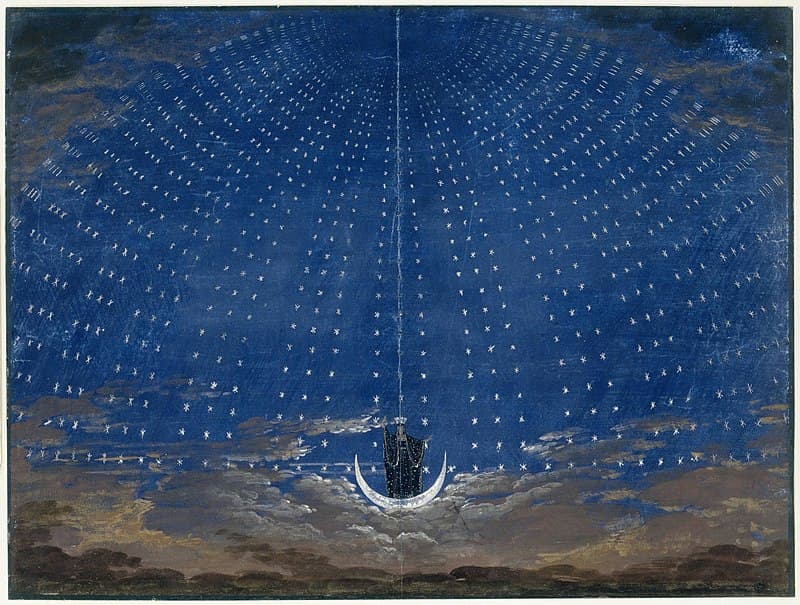
Karl Friedrich Schinkel: Stage set for the Queen of the Night (in Mozart’s Magic Flute)
It wasn’t much of a competition as Salieri’s Prima la Musica, poi le Parole (First the Music and then the Words) in the fashionable Italian style, soundly defeated Mozart’s Schauspieldirector (The Impresario). The plan of the Emperor, who was hoping for Mozart and German opera to win the day, failed badly that evening. However, Mozart soon demonstrated his mastery of both genres with Le nozze di Figaro and the Magic Flute. And in the end, of course, he did accomplish what he set out to do in his famous quote.
Wolfgang Amadeus Mozart: The Magic Flute, “Queen of the Night”
“I care very little for Salzburg and not at all for the archbishop; I shit on both of them”
The city of Salzburg has always been a small but pretentious provincial town. A few selected families got very rich from the salt trade, and they controlled and dominated virtually all aspects of civic and ecclesiastical life. That ruling civic elite had very little interest in having a gifted composer interfere with their conservative practices. Mozart was the musical servant of Archbishop Hieronymus von Colloredo, and he was well aware of Mozart’s distaste for the city and for his own person.
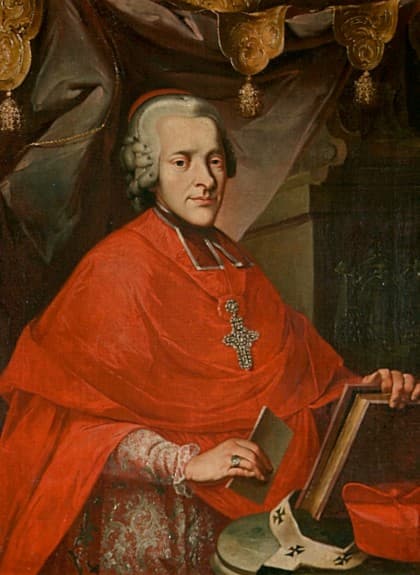
Hieronymus von Colloredo (1732-1812), Prince-Archbishop of Salzburg
The Archbishop became exceptionally annoyed with Mozart’s frequent absences resulting in a number of heated arguments. Breaking with the Archbishop was not going to be easy, and Mozart lobbied and even begged his father for support. He wanted to be a freelance musician, and was rightfully tired of being “spoken to as if I had been some miserable beggar.” Their working contract was resolved in May 1781, when the chief chamberlain delivered a swift kick to Mozart’s backside. Isn’t it ironic that present-day Salzburg continues to reap the financial rewards of a relationship that never existed?
“Death, when we come to consider it closely, is the true goal of our existence”
Wolfgang Amadeus Mozart lived during a period of history when high mortality was simply a fact of life. Several of his siblings died in childhood, and the union of Wolfgang and Constanze produced six children, but only two survived infancy. Wolfgang was deeply affected by the death of his father, and his mother died of a long and painful illness. His own health had started to deteriorate at the age of five. He suffered from rheumatism, which frequently caused kidney infections that confined him to bed.

Austria, Vienna, St. Marx Cemetery, The gravestone of Wolfgang Amadeus Mozart
Mozart had plenty of time to consider his own mortality, and he writes, “I have formed during the last few years such close relationships with this best and truest friend of mankind that death’s image is not only no longer terrifying to me, but is indeed very soothing and consoling, and I thank my God for graciously granting me the opportunity… of learning that death is the key which unlocks the door to our true happiness. I never lie down at night without reflecting that, young as I am, I may not live to see another day.”
Wolfgang Amadeus Mozart: Mass in C minor, K. 427 “Kyrie”
“Shit in your bed and make it burst”
The nine surviving letters by Wolfgang Amadeus Mozart to his cousin Maria Anna Thekla Mozart are known as the “Bäsle Letters.” She was the daughter of one of the brothers of Mozart’s father Leopold, and in his letters Mozart famously uses direct and frank language, which is sometimes drastically vulgar and spiced with anal-erotic fantasies. This kind of scatological humor has puzzled scholars, and more recently, it is claimed to originate in psychiatric conditions from which Mozart supposedly suffered.
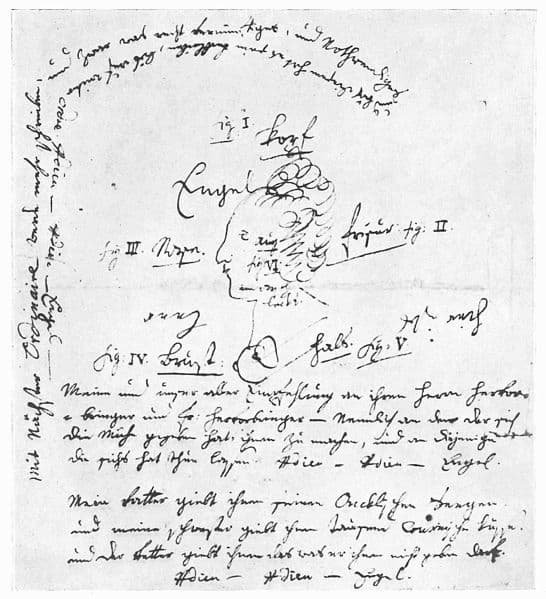
A drawing by Mozart in his Basel Letters to her cousin Maria Anna Thekla
For some commentators, “Mozart was able for a moment to forget the continuous pressures of an uncertain future, and allowed his light-hearted and humorous side of his character to come through.” One thing for sure, “these letters embarrass us, and we have tried to suppress them, trivialize them, or explain them away with pathological excuses.” It might well be that 18th-century scatological humor was far more public and mainstream, and it might well have suggested a political dimension. In a letter to his father, he describes the aristocrats present at a concert in Augsburg as “Duchess Smackarse, Countess Pleasurepisser, the Princess Stinkmess, and the two Princes Potbelly von Pigdick.”
Wolfgang Amadeus Mozart: “Leck mich am Arsch” (Kiss my Ass), K. 231
“What’s even worse than a flute? – Two flutes!”
We still don’t know for certain if this famous quote can be wholly attributed to Wolfgang Amadeus Mozart. However, we do know that he did not like the sound of the solo flute and found it difficult to compose for the instrument. As he was struggling to fulfill a commission for the wealthy amateur flautist he truly loathed, he writes to his father. “I never have a quiet hour here… besides, one is not always in the mood for working. I could certainly scribble things the whole day long, but when a composition of this kind goes out into the world, naturally I do not want to be ashamed of my name on the title page. Moreover, you know I am quite powerless to write for an instrument (the flute) which I cannot bear.”
As we might well imagine, countless famous quotes by Wolfgang Amadeus Mozart have been misattributed. I guess, if you are famous and dead, people are ever so happy to put words in your mouth. What is your favorite Mozart quote?
Musings on Schubert
by Anson Yeung
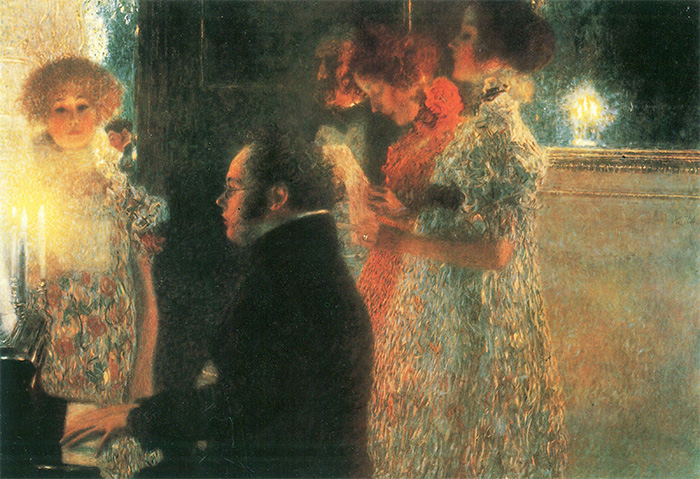
Schubert at the Piano – Gustav Klimt (1899)
Schubert is probably the only composer who can create music that is even more heart-wrenching and disturbing in major keys than in minor keys. An example I would immediately think of would be his Klavierstücke No. 2 in E-flat major. Starting with a gentle and intimate atmosphere, it then transits into the tumultuous first trio and later the more poignant second trio in A-flat minor. There’s a moment where the music suddenly detours into A-flat major (a dominant seventh technically) for merely one bar and then returns to the original tonality. Compare 6:36 and 9:07 in the recording below – this never fails to give me goosebumps, as if there’s finally a gleam of hope, but it’s extinguished in a matter of seconds.
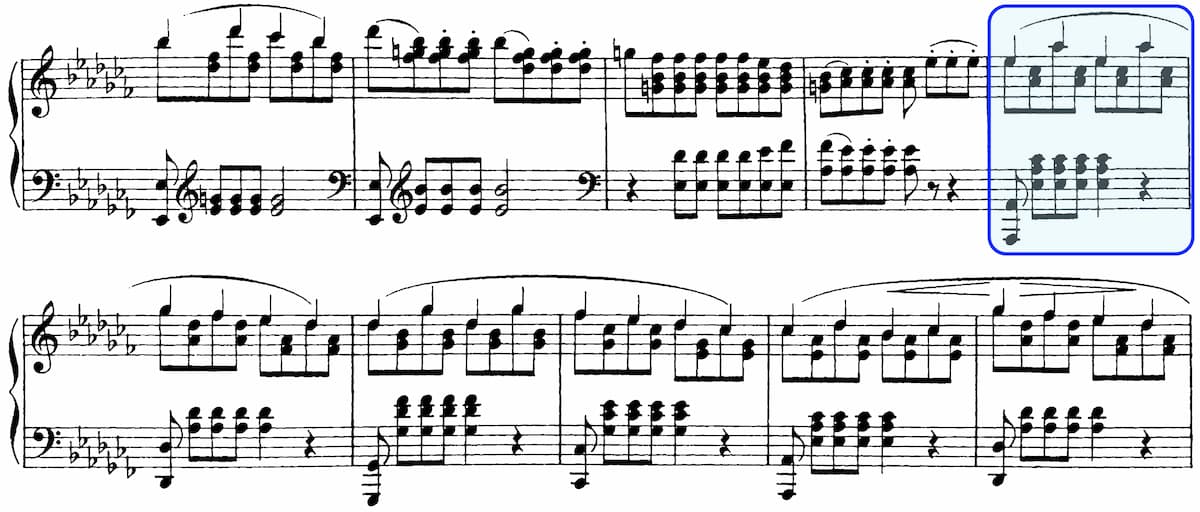
Figure 1
The bar highlighted in blue appears for the first time in A-flat minor.
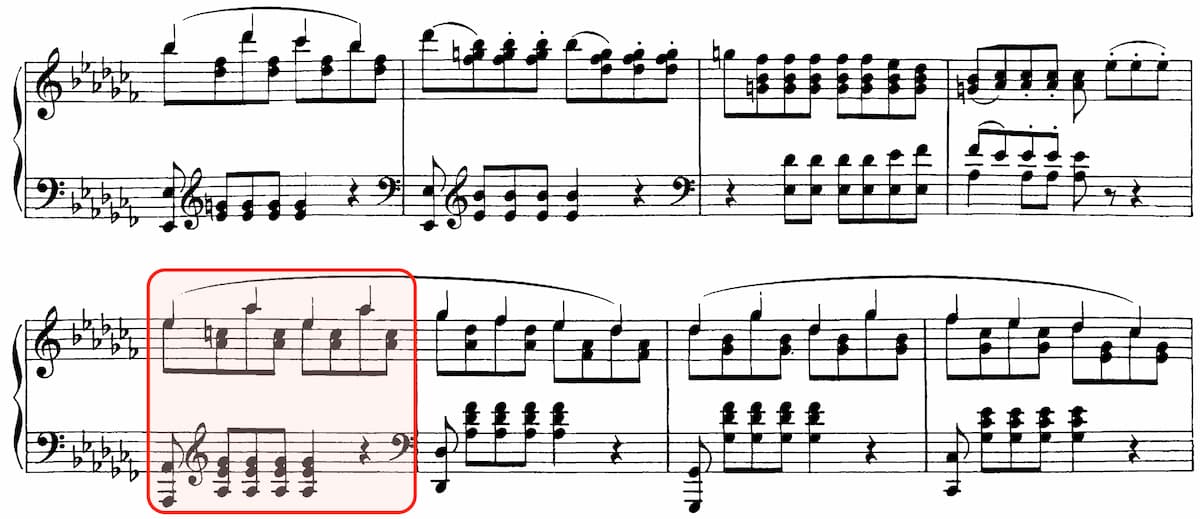
Figure 2
This time it is in A-flat major but returns to the original tonality after one bar.
Schubert is always a complex figure, with his music oozing so much nostalgia, hope, loss, grief, frustration, and many more. All these emotions are what make human beings fragile, but at the same time, what make us human. His music is often suffused with bittersweetness, in the sense that the apparently more joyous moments are, in fact, reminiscences of the unattainable past, while the music often draws us back to the darker side as if an interrupted dream.
Paul Lewis illuminated Schubert’s emotional landscape with an uncompromising interpretation of his sonatas in Hong Kong. In the Sonata in A major, D.664, I experienced embracing warmth, a sense of relief despite tinges of sorrow, and the imagery of rustic scenes, with the third movement full of buoyancy and a dancing pulse. On the other hand, Schubert’s neuroses and anguish fully came through in the Sonata in A minor, D. 845, coupled with such abandon and immensely white-hot passion from Lewis.
In my interview with Paul Lewis, he aptly described the “lack of resolution” in Schubert’s music, with which I greatly sympathise. Schubert often brings up conflicts without offering an answer, leaving us in a state of ambivalence. That’s something that makes his music close to my heart – after all, not everything in the world has or requires a resolution or an answer. Unlike Beethoven, Schubert accepted his fate as it was, and such an acceptance is most evident in his late sonatas.
Chopin once said, ‘Bach is an astronomer, discovering the most marvellous stars. Beethoven challenges the universe. I only try to express the soul and the heart of man.’ We can perhaps draw a parallel here. Schubert neither explored the topics of divinity and religion nor attempted to fight against his fate. Instead, it is all about the deepest, often ineffable human emotions, which is probably why listening to his music can provoke such a probing ache.
As with Schubert’s music, this piece of musing (or nonsensical mumbling for some) shall come to an end without a resolution, which is paradoxically yet to be discovered in his music per se.
Decoding My Playlist: What Does My Music Player Think I Like?
by Fanny Po Sim Head
With technological advancements, our music players can now generate a list of music tailored to our preferences, matching our usual choices at different times of the day. It is both bizarre and fascinating to discover what our music player thinks we like. Sometimes, these suggestions reveal patterns we didn’t consciously notice, offering a fresh perspective on our musical inclinations.

© az616578.vo.msecnd.net/
When I decided to write an article about my favorite composers and their piano compositions, I scrolled through the selections my music player suggested. To my surprise—or perhaps not—I genuinely enjoyed many of them. The curated playlists seemed to echo my preferences, yet they also introduced me to pieces I hadn’t considered in a long time, sparking new reflections on familiar music.
My favorite composer is J.S. Bach, and my music player often includes a piece or two of his. At the top of my list is one of his 1741 compositions, the Goldberg Variations. I am captivated by its simple, delicate, and somewhat moody opening. Named after one of Bach’s pupils, who is said to have played the variations to help his noble employer sleep, the work never fails to draw me in. Its seamless blend of technical brilliance and emotional depth make it an enduring masterpiece. Each time it appears on my playlist, it feels like a trusted companion, affirming my deep connection to Bach’s artistry.
Bach’s Goldberg Variations [Glenn Gould, 1981 record] (BWV 988)
Recently, I have been revisiting another Bach masterpiece: English Suite No. 2 in A Minor, BWV 807: I. Prélude. This piece took on a new context for me when I learned it was featured in a chilling film scene where a Nazi officer played the Prelude while the SS officers massacred Jewish residents who refused to relocate to concentration camps. The juxtaposition of this serene, intricate music with such horrific imagery is deeply unsettling. The music player’s suggestion of this piece prompted me to reflect on the complex history of classical music and its associations.
English Suite No. 2 in A Minor, BWV 807: I. Prélude
Watch the scene (content warning):
While this association is haunting, it does not diminish the intrinsic beauty of the piece for me. Bach’s music often transcends time and context, resonating with listeners across centuries. My music player’s inclusion of this work made me appreciate anew its timeless appeal.
Moving on to Beethoven, the last movement of his Op. 109 is one of my favorite piano works. It has a unique quality—simultaneously static and profoundly moving. The intertwining themes and variations create a meditative yet dynamic experience, showcasing Beethoven’s unparalleled genius in blending structure with emotion. Its frequent appearance on my playlist often feels like an invitation to pause and immerse myself in its profound serenity.
Beethoven: Piano Sonata Op. 109
Lately, I have also been exploring Beethoven’s piano concertos. My music player initially suggested his 3rd Concerto, but my recent favorite is the 4th. Its hopeful yet understated tone, combined with the delicate orchestral entrance after the piano’s brief opening, has captivated me. This concerto strikes a balance between intimacy and grandeur, making it a perfect companion for reflective moments, which aligns seamlessly with my playlist’s mood-based suggestions.
Beethoven: Piano Concerto No. 4
Another composer who frequently appears on my playlist is Scriabin. One of the daily playlists suggested his Prelude Op. 16, No. 4, but I’ve found No. 1 from the same opus equally charming, soothing, and warm. Scriabin’s music, often described as mystical and otherworldly, offers a fascinating contrast to the structured works of Bach and Beethoven. Discovering these pieces through the music player has deepened my appreciation for Scriabin’s unique voice.
Scriabin : Prélude Op. 16 No. 1
Exploring different styles of music, particularly from South American composers, is another joy. My music player recently introduced me to Alberto Nepomuceno’s Prece. Nepomuceno, often regarded as the “Father of Brazilian music,” blended popular and folk elements into his compositions, leaving a lasting influence on Brazilian concert music. His legacy continued through his students, including Heitor Villa-Lobos. Prece is a poignant piece that captures the essence of Brazilian musical identity while remaining universally appealing. Its appearance on my playlist felt like a gentle nudge to explore more from this fascinating repertoire.
Alberto Nepomuceno: Prece
Another South American composer whose works I’ve been exploring is Carlos Guastavino. Often called the “Schubert of the Pampas,” Guastavino is celebrated for his romantic and deeply lyrical compositions. Although not featured in my music player’s current playlist, his piano works often embody a lyrical and nostalgic quality that resonates deeply with listeners. His music reflects the landscapes and folk traditions of Argentina, blending classical techniques with the emotional warmth of his homeland. Reflecting on Nepomuceno’s influence naturally led me to revisit Guastavino’s compositions, showcasing how playlists can act as a springboard for broader musical exploration.
Carlos Guastavino: Cantilena n. 5 “Abelarda Olmos”
Lastly, one piece that always seems to find its way into my playlist is Franck’s Prélude, Fugue et Variations. It’s not only a joy to listen to but also a piece I love to play. Franck’s ability to weave intricate counterpoint with expressive melodies is truly remarkable. This work, with its blend of technical challenge and emotional depth, remains a staple in my musical journey. My music player’s recurring suggestion of this piece feels like a constant reminder of its enduring significance.
César Franck: Prélude, Fugue, et Variation
These discoveries have made me reflect on how well my music player knows my tastes. It’s a delightful and sometimes eerie experience to see my preferences mirrored back to me through algorithms and data. At the same time, the suggestions serve as a springboard for exploration, introducing me to new works and composers I might not have otherwise encountered. This interplay between familiarity and discovery keeps my musical journey dynamic and enriching.
What about you? What does your playlist suggest you listen to? What does your music player think you like? Perhaps it’s time to dive into your playlists and uncover some surprises.
Slithering into Fortune: Happy Chinese Year of the Snake
by Hermione LAI
This year promises to be filled with transformation and growth, and whether you are looking for big changes or small wins, there is a magical energy in the air. The snake may be mysterious, but it is also very powerful, resourceful and ready to lead us towards a new beginning.
The Wood Snake

In the Chinese zodiac, the snake occupies the sixth position, and it is associated with wisdom, charm, elegance, and transformation. People born in the Year of the Snake are supposed to be intuitive, strategic, and intelligent. In 2025, the Year of the Snake starts on 29 January and ends on 16 February. 2025 is the year of the Wood Snake, associated with growth, creativity, and expansion.
People born under the influence of the Wood snake tend to be highly creative. Highly innovative and artistic, they have a natural ability to create new ideas and come up with solutions. Individuals also exhibit a strong sense of nurturing and caring, making them more emphatic and concerned about others. And since wood can bend without breaking, Wood Snakes are uniquely capable of adapting and can go with the flow when necessary.
Love Life

It has been predicted that individuals born under the zodiac of the snake will experience a particularly vibrant and fulfilling love life. Their natural charm and allure will make it easy for them to attract members of the opposite sex, leading to a year filled with romantic opportunities and excitement. Wood Snakes tend to be more reserved in the beginning stages of a relationship, so it may take time for attraction to turn into something more lasting.
However, it is advisable to exercise caution and avoid indulging in their romantic pursuits. Excessive behaviour can complicate relationships and lead to unintended consequences, such as unwanted pregnancies. By setting boundaries and using their intelligence and judgment, Snakes can enjoy romance without facing complications. Your best matches are the Rooster, Ox, and Dragon, but you should absolutely stay away from Monkey and Tiger.
Money
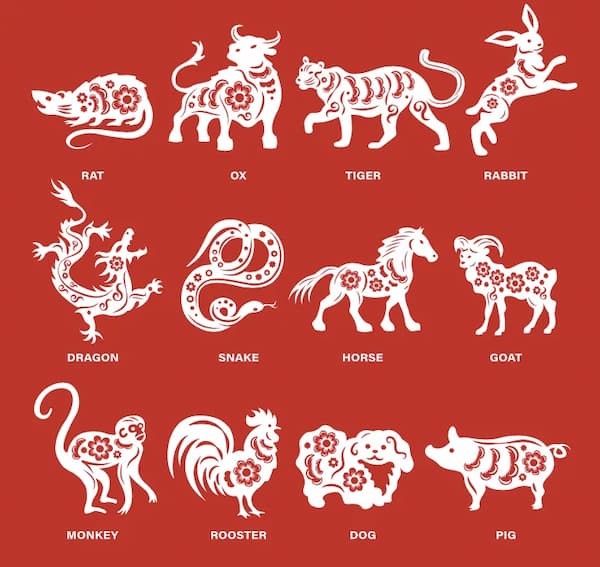
2025 looks quite promising for Wood Snakes in terms of wealth, income, and family growth. There might be opportunities for financial growth through strategic investments, planning, or business ventures. If you’ve been waiting for the right moment to take a financial leap, such as investing in stocks, real estate, or starting a business, this may well be a good year to move forward, but only after careful consideration and planning.
It has been predicted that 2025 will be particularly beneficial for individuals in the communication sector and that collaborations with foreign companies may lead to additional income. However, Wood Snakes can be drawn to indulgent spending, especially on luxury items. Be mindful of your financial habits in 2025, especially when it comes to unnecessary purchases. Set a clear budget and stick to it, ensuring that you prioritise your financial goals over momentary desires.
Health

Even though the physical energy might be high, the Wood Snake might be vulnerable to stress and mental fatigue in 2025. Sometimes, individuals born under that sign tend to overthink and strategise, leading to excessive worrying. Please be careful, as emotional health might be impacted.
It’s always a good idea to incorporate relaxation techniques like meditation, yoga, or deep-breathing exercises into your daily routine. Allow yourself moments of downtime to decompress from the mental and emotional pressures you face. And if you are prone to anxiety, you might find that stress manifests physically, such as tension headaches, digestive issues, or muscle strains.
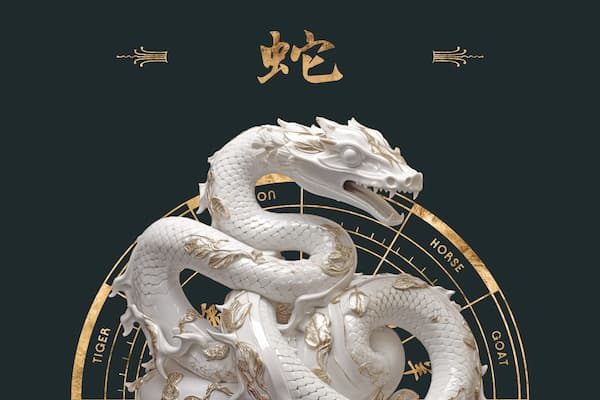
2025 will likely be a wonderful year if you are born under the sign of the Snake, as you will experience significant growth and transformation driven by a balance of strategic planning, emotional awareness, and a deepening of both personal and professional connections. You will navigate all challenges with patience and resilience.
Happy Chinese New Year! May the Year of the Snake bring you wisdom, prosperity, and endless joy!

